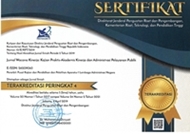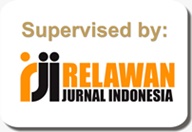Pedoman Praktis Penyusunan Kamus Kompetensi Teknis Aparatur Sipil Negara
Abstract
Competency dictionary and job standard for Indonesian civil servant has been exposed in The Decree of Ministry of Administrative and Bureaucratic Reform Number 38 Year of 2017. This decree gives ample explanation on managerial and social-cultural competencies, including the exact lists of competency titles and the application toward each job level. On the other hand, the similar treatment does not applied toward technical competency, only general guidance included. Since all ministries and non-ministerial government institutions must develop technical competency dictionary and job standard for their own governmental affairs, thus the need of the guidance is heightened. This study aims for creating practical guidance in developing technical competency dictionary along with the example. Qualitative approach with case study was used in this study. Moreover, data was gathered through literature examination, focus group discussion, and workshop. As the result, there are three steps in developing technical competency dictionary, ie: (1) identifying technical competency title using organization main duties and function cascading technique; (2) deciding technical competency levels using Taxonomy Bloom theory; and (3) writing down compatible behaviour indicators using guidance matrix. In addition, example provided for every step in order to ease the guidance practicality. Hopefully, this practical guidance could help human resource practitioner in developing technical competency dictionary, especially in Indonesian civil servant context. Furthermore, this article will add different perspective toward competency studies.
Keywords
Full Text:
PDFReferences
Ahuja, S. (2012). Strategic alignment maturity model (SAMM) in a cascading balanced scorecard (BSC) environment: Utilization and challenges. In Heidelberg (Ed.), International Conference on Advanced Information Systems Engineering (pp. 567–579). Berlin: Springer.
Alsabbah, M. Y. A., & Ibrahim, H. I. (2013). Employee Competence (Soft and Hard) Outcome of Recruitment and Selection Process. In American Journal of Economics 2013, 3 (pp. 67–73). Scientific & Academic Publishing. https://doi.org/10.5923/c.economics.201301.12
Anderson, L. W. (Ed. ., Krathwohl, D. R. (Ed. ., Airasian, P. W., Cruikshank, K. ., Mayer, R. E., Pintrich, P. R., … Wittrock, M. C. (2001). A taxonomy for learning, teaching, and assessing: A revision of Bloom’s Taxonomy of Educational Objectives (Complete edition). New York: Longman.
Athanassiou, N., McNett, J. M., & Harvey, C. (2003). Critical Thinking In The Management Classroom: Bloom’s Taxonomy As A Learning Tool. Journal Of Management Education, 27, 533–555. https://doi.org/10.1177/1052562903252515
Blašková, M., Blaško, R., & Kucharčíková, A. (2014). Competences and competence model of university teachers. Procedia-Social and Behavioral Sciences, 159, 457–467.
Bloom, B. S. (Ed. ., Engelhart, M. D., Furst, E. J., Hill, W. H., & Krathwohl, D. R. (1956). Taxonomy of educational objectives: The classification of educational goals (Handbook 1). New York: David McKay.
Bonder, A., Bouchard, C.-D., & Bellemare, G. (2011). Competency-Based Management--An Integrated Approach to Human Resource Management in the Canadian Public Sector. Public Personnel Management, 40 No. 1, 1–10.
Borisova, L. (2015). Professional аnd Emotional Competence оf Civil Servants. Economic Alternatives, (3), 97–104.
De Beeck, S. O., & Hondeghem, A. (2010). Competency Management in the Public Sector: Three Dimensions of Integration.
Falender, C. A., & Shafranske, E. P. (2004). Clinical supervision: A competency-based approach. Washington, DC: American Psychological Association.
Gómez-Arizaga, M. P., Conejeros-Solar, M. L., & Martin, A. (2016). How good is good enough? A community-based assessment of teacher competencies for gifted students. SAGE Open, 6(4). https://doi.org/10.1177/2158244016680687
Hill, P. W., & McGaw, B. (1981). Testing the simplex assumption underlying Bloom’s taxonomy. American Educational Research Journal, 18(1), 93–101.
Huang, I. Y., Wu, W. W., & Lee, Y. T. (2008). Simplifying essential competencies for Taiwan civil servants using the rough set approach. Journal of the Operational Research Society, 59(2), 259–265.
ILO. (2015). Regional Model Competency Standards: core competencies / Regional Skills Programme, ILO Regional Office for Asia and teh Pasific. Bangkok: ILO.
Jackson, D., & Chapman, E. (2012). Non-technical competencies in undergraduate business degree programs: Australian and UK perspectives. Studies in Heigher Education, 37(5), 541–567.
Kementerian Pemberdayaan Aparatur Negara dan Reformasi Birokrasi. (2019). Standar Kompetensi Jabatan Pegawai ASN. KemenPAN-RB.
Krathwohl, D. R. (2002). A Revision of Bloom’s Taxonomy: An Overview. Theory Into Practice, 41(4), 211–218. https://doi.org/10.1207/s15430421tip4104_2
Kusuma, M. D., Rosidin, U., Abdurrahman, & Suyatna, A. (2017). The Development of Higher Order Thinking Skill (HOTS) Instrument Assessment in Physics Study. IOSR Journal of Research & Method in Education, 7(1).
Li, J. M., Yang, J. S., & Wu, H. H. (2008). Improving Service Quality and Organisation Performance Through Human Resource Practices. Total Quality Management, 19(9), 969–985.
Liukinevičienė, L. (2017). Implementation Of The Civil Service Competency Model In Lithuania. Scientific Papers of the University of Pardubice, 24(40), 132–142.
Loch, C. H. (2008). Mobilizing An R&D Organization Through Strategy Cascading. Research-Technology Management, 51(5), 18–26. https://doi.org/10.1080/08956308.2008.11657522
Lum, A. (2005). Assessment Centre: Simulator for Organisation Talents. Singapore: Pacific Century Consulting Pte Ltd.
Martíneza, P. Á. L., Morenob, J. J. M., & Brageb, L. B. (2014). Analysis of professional competencies in the Spanish public administration management. Journal of Work and Organizational Psychology, 30, 61–66. https://doi.org/10.1016/j.rpto.2014.06.001
Martynova, S. E., & Maslennikova, O. G. (2015). The “Service” Model of the Competences of the Municipal Employee as the Basis of Vocational Training: Russian Experience. In Procedia-Social and Behavioral Sciences (pp. 2716–2720). Elsevier Ltd. https://doi.org/10.1016/j.sbspro.2015.01.957
Noe, R. A. (2010). Employee Training and Development. ((5th ed.)). New York: McGraw-Hill/Irwin.
Ober, A. M., Granello, D. H., & Henfield, M. S. (2009). A synergistic model to enhance multicultural competence in supervision. Counselor Education and Supervision, 48(3), 204–221.
Peraturan Lembaga Administrasi Negara Nomor 1 Tahun 2019 tentang Organisasi dan Tata Kerja.
Peraturan Menteri Pendayagunaan Aparatur Negara dan Reformasi Birokrasi RI Nomor 38 Tahun 2017 tentang Standar Kompetensi Jabatan Aparatur Sipil Negara.
Rainsbury, E., Hodges, D. L., Burchell, N., & Lay, M. C. (2002). Ranking Workplace Competencies: Student and Graduate Perceptions. Asia-Pacific Journal of Cooperative Education, 3, 9–18.
Sartika, D., & Kusumaningrum, M. (2017). Pengembangan Kompetensi Aparatur Sipil Negara di Lingkungan Pemerintah Provinsi Kalimantan Timur. Jurnal Borneo Administrator, 13(2), 131–149.
Shippmann, J. S., Ash, R. A., Batjtsta, M., Carr, L., Eyde, L. D., Hesketh, B., Kehoe, J., … Sanchez, J. I. (2000). The Practice of Competency Modeling. Personnel Psychology, 53(3), 703–740.
Skorková, Z. (2016). Competency models in public sector. In Procedia - Social and Behavioral Sciences (pp. 226–234). Elsevier Ltd. https://doi.org/10.1016/j.sbspro.2016.09.029
Snell, L. S., & Frank, J. R. (2010). Commentary: Competencies, The Tea Bag Model, and The End of Time. Medical Teacher, 32, 629–630. https://doi.org/10.3109/0142159X.2010.500707
Spencer, L. M., & Spencer, P. S. M. (1993). Competence at Work models for superior performance. Canada: John Wiley & Sons.
Swanson, R. A. (1995). Human Resource Development: Performance is the key. Human Resource Development Quarterly, 6(2), 207–213.
Vathanophas, V., & Thai-ngam, J. (2007). Competency Requirements for Effective Job Performance in The Thai Public Sector. Contemporary Management Research, 3(1), 45–70.
Whitcomb, C. A., Delgado, J., Khan, R., Alexander, J., White, C., Grambow, D., & Walter, P. (2015). The Department of the Navy systems engineering career competency model. In Proceedings of The Twelfth Annual Acquisition Research Symposium, Wednesday Sessions.
Whitcomb, C. A., Khan, R., & White, C. (2014). Development of a System Engineering Competency Career Development Model: An Analytical Approach Using Bloom’s Taxonomy. Systems Engineering Competency Career Model (SECCM), (FY2013) Technical Report.
White, C. L. (2014). Development of Systems Engineering Competency Career Development Model: An Analytical Approach using Blooms Taxonomy. Naval Postgradate School Monterey CA.
Xiaoyun, C., & Im, T. (2009). The Basic Models, Characteristics, and Directions of Civil Service Reform in China: Based on Analysis of the Competence of the Civil Service. International Review of Public Administration, 14(2), 53–62. https://doi.org/10.1080/12294659.2009.10805155
Yang, J., Zhang, Z.-X., & Tsui, A. S. (2010). Middle Manager Leadership and Frontline Employee Performance: Bypass, Cascading, and Moderating Effects. Journal of Management Studies, 47, 654–678. https://doi.org/10.1111/j.1467-6486.2009.00902.x
DOI: http://dx.doi.org/10.31845/jwk.v23i1.155
Refbacks
- There are currently no refbacks.
Copyright (c) 2020 Hendra Nugroho Saputro, Agus Wahyuadianto

This work is licensed under a Creative Commons Attribution-NonCommercial-ShareAlike 4.0 International License.
JURNAL WACANA KINERJA INDEXED BY:
__________________________________________________________________________________________________________
@2023 Center fo State Civil Apparatus Training and Development and Competency Mapping (Pusat Pelatihan dan Pengembangan dan Pemetaan Kompetensi Aparatur Sipil Negara Lembaga Administrasi Negara - Puslatbang PKASN LAN) Jl. Kiara Payung KM. 4, 7 Jatinangor, Sumedang, Jawa Barat 45366 Telp. (022) 7790048-7790044-7790049-7782041-7782042 Fax. (022) 7790055-7782178; Email: wacanakinerja@yahoo.com; wacanakinerja@gmail.com
Powered by OJS
















